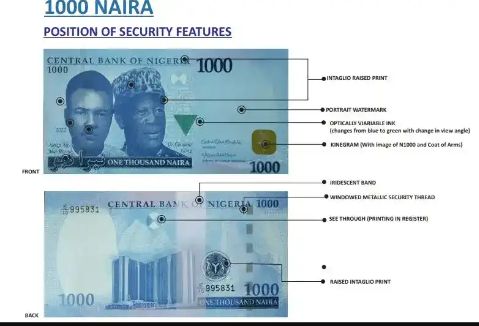Numerous security mechanisms shield the Naira banknotes, making it possible to identify authentic notes with ease. Raised print, security thread, and watermark are the differentiating characteristics that can be identified by touch and visibility.
Fake notes of the new N1,000 Naira notes have been circulating in the market since the Central Bank of Nigeria (CBN) introduced the redesigned Naira currency in the denominations of N200, N500, and N1,000.
A counterfeit piece of money has been made without the state’s government’s legal approval. It is possible to distinguish authentic Naira notes from counterfeit ones in the economy without formal education if you know what to look for.
These five straightforward guidelines for a Naira note will enable you to tell a fake note from a real one.
1. Verify the texture.
You have the right to be worried, reject the Naira note, and ask for another if the texture is soft and the image is dull.
This means that if you are engaged in a transaction, you should be sensitive to the touch of the money you are handed.
2. Take note of the gold foil
Near the CBN governor’s signature on the right side of the N1000 note is a gold foil. The gold foil on a false note will immediately peel off when scratched, but it does not peel off an original note.
3. Utilize liquids such as water
Using water or another liquid will help you distinguish between phony and genuine cash. The colors used by scammers to print counterfeit notes are soluble in water and some other liquids.
If you are unsure of the authenticity of a Nigerian note, carefully clean it with water or gasoline. If it’s phony money, the colors will change right away. Like a watercolor painting, counterfeit money’s colors will fade over time.
Once more, the paper gets messed up the second you submerge it in water. It will become more ragged and resemble paper mache. The real note, however, won’t appear like this when submerged in water or any other liquid.
4. Inspect the ribbon or thread
On every Naira note, a ribbon-like thread that runs from top to bottom may be seen. This thread can be sensed by touching actual notes. On older Naira bills, it is more obvious. However, there is a feature in bogus notes that resembles the thread but is false.
What is shown on the fake notes is merely a painting made of straight lines that mimic the thread on the real notes. The artwork will peel off if it is scratched, just like the recharging card solver panel.
5. Utilize mercury-based lights.
Naira makes a note of several characteristics of the paper that are invisible to the naked eye. Only original Naira notes have these traits, and only mercury bulbs can be used to see them.
For instance, a real N1000 note will display a glowing 1000 (in digits) printed across it when exposed to the light from a mercury lamp. Similar rules apply to smaller denominations. Anyone can tell authentic Naira notes from phony ones by using the five straightforward methods mentioned above.
In conclusion, The lower right corner of the original note contains a gold seal that cannot be removed by scratching. The new one has a gold seal at the bottom of the right side of the note near the signatures, but the previous one does not.











